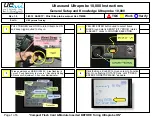
5
rotate it about all three axes. The graph below shows the result. The graph has all
three components of acceleration and the net acceleration (the square root of the sum
of the squares of the accelerations). The bottom graph is the net acceleration. Notice
that it stays near 9.8 m/s
2
throughout all of this rotation.
Rotating the 3-Axis Accelerometer
The 3-Axis Accelerometer is designed to measure small accelerations with minimal
electronic noise. The noise is typically on the order of 0.5 m/s
2
peak to peak. The
offset voltage (voltage output at 0 m/s
2
) will drift somewhat with temperature.
Vernier produces three other accelerometers:
•
25-
g
Accelerometer (ACC-BTA). Use for collision experiments or for
centripetal acceleration experiments with larger accelerations.
•
Low-
g
Accelerometer (LGA-BTA). This is a, one-dimensional version of the
3-Axis Accelerometer.
•
Wireless Dynamics System Sensor (WDSS). A 3-axis accelerometer, altimeter,
and force sensor in one unit that communicates wirelessly with your computer.
This sensor is equipped with circuitry that supports auto-ID. When used with
LabQuest, LabQuest Mini, LabPro, Go! Link, SensorDAQ, EasyLink, or CBL 2, the
data-collection software identifies the sensor and uses pre-defined parameters to
configure an experiment appropriate to the recognized sensor.
Do I Need to Calibrate the 3-Axis Accelerometer?
You should not need to calibrate this sensor. Each sensor is calibrated prior to being
shipped to you. The measurement being made by this sensor is complex and can be
difficult to analyze, so be sure to read the Frequently Asked Questions below. In most
experiments you can simply use the default calibration, but then use the software’s
zeroing option and zero the sensor along the axes.
Most accelerometers, including this one, sense gravity as well as acceleration. This can
make results more difficult to understand, but it provides an easy calibration method.
Calibration may be done using the acceleration due to gravity. To calibrate the sensor
for measuring acceleration in the horizontal direction, position the Accelerometer with
6
the arrows pointing down for the first calibration point. Define this as –9.8 m/s
2
or
–1 g. Rotate the Accelerometer so the arrows point up and use the reading for the
second calibration point. Define this as +9.8 m/s
2
or +1 g. The Accelerometer will then
read 0 with no acceleration when held horizontally. Repeat this procedure for each
axis. If you want to calibrate for measuring acceleration in the vertical direction, follow
the procedure above, but define the first calibration point as 0
g
or 0 m/s
2
and the
second point as 2
g
or 19.6 m/s
2
.
Using the 3-Axis Accelerometer as a Single Axis Accelerometer
Since the 3-Axis Accelerometer is equivalent to three Low-g Accelerometers, you
can use just one channel of it to study acceleration along a single axis. Just mount
the accelerometer so that a particular axis is in the direction of interest and monitor
just that channel. If the motion is linear, it will keep the analysis simple.
Suggested Experiments
Since the 3-Axis Accelerometer is equivalent to three Low-g Accelerometers, you
can also do any experiment that uses only one or two axes. Examples include:
•
Measure the acceleration of dynamics carts as they roll down inclines or have
force applied to them.
•
Measure acceleration
vs
. time on elevators, remote-controlled cars, bicycles, or
automobiles.
•
Use the accelerometer to measure the tilt of an object. Since each channel of
the accelerometer senses the vertical component of gravity, its reading will
change as its orientation is changed from horizontal to vertical. You can
measure angles to the nearest degree.
The 3-Axis Accelerometer can also be used to collect data in more complex
experimental settings such as:
•
Amusement park rides such as roller coasters, swings, swinging ships, and Tilt-
a-Whirl.
•
Bungee jumps done by dolls or humans.
•
Place the accelerometer and interface in a padded box and toss it in the air.
Compare the three individual accelerations to the net acceleration.
3-Axis Accelerometer tossed in the air but not rotated
In the graph above, the box was tossed in the air but not rotated. Notice that the x-
and z-axis accelerations before the toss are zero whereas the y-axis acceleration is






















